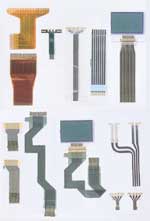|
Flexible Printed Circuit Boards
(NGI Flex)

|
Summary:

NGI Flex is an FPC developed so that high-degree flexibility and highly densified mounting can be realized by fusing a heat Seal connector into FPC with the company's original printing technology. It can expand a range of designing.
Furthermore, "Anisotropic conductive adhesive", an original hot-melt material developed by the company, has responded to customers' requirements by simplifying connection, improving reliability, and reducing total cost.
Characteristics:

- Compliance with the high-densification and smaller-and-lighter requirements
- High reliability by low-temperature pressure-adhesion
- Total cost reduction
Composition:

1. FPC, single-sided type
This is an FPC with a conductive circuit on one side of the base film.
The company's original hot-melt material can be stored at normal temperature unlike ACF, and pressure-adhered at low temperature.
2. FPC/HSC, composite type
This is a new connector with FPC and HSC integrated with the company's own manufacturing method. Both types are available: one-sided and two-sided types.
It is characterized by highly densified mounting with the resistance stability of FPC and the high-degree flexibility (completely bendable) of HSC combined.
The connection to COG can be done at low temperature by rendering the adhering part heat seal. Wiring to the reverse side via a through hole renders the wiring board more densified by expanding the degree of freedom of circuit design.
Application:

- Various connectors for drawing COG modules
- Touch panels
- LCD modules
- PCB
|